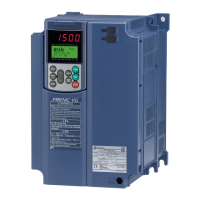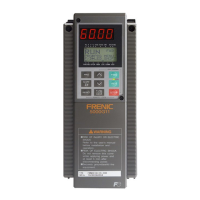5-100
F codes
E codes
C codes
P codes
H codes
A codes
b codes
r codes
J codes
d codes
U codes
y codes
Chap. 5 FUNCTION CODES
Number of reset times (H04) Data setting range: 0 (Disable), 1 to 10 (times)
H04 specifies the number of reset times for the inverter to automatically attempt to escape the tripped state.
If the "auto-reset" function has been specified, the inverter may automatically restart and run the motor stopped due
to a trip fault, depending on the cause of the tripping.
Design the machinery so that human body and peripheral equipment safety is ensured even when the auto-resetting
succeeds.
Otherwise an accident could occur.
Reset interval (H05) Data setting range: 0.5 to 20.0 (s)
H05 specifies the reset interval time between the time when the inverter enters the tripped state and the time when it
issues the reset command to attempt to auto-reset the state. Refer to the timing scheme diagrams below.
<Operation timing scheme>
• In the figure below, normal operation restarts in the 4-th retry.
• In the figure below, the inverter failed to restart normal operation within the number of reset times specified by H04
(in this case, 3 times (H04 = 3)), and issued the alarm output (for any alarm)
ALM.
Auto-resetting -- TRY (E20 to E24 and E27, data = 26)
This output signal comes ON when auto-resetting (resetting alarms automatically) is in progress.
H06 Cooling Fan ON/OFF Control
To prolong the service life of the cooling fan and reduce fan noise during running, the cooling fan stops when the
temperature inside the inverter drops below a certain level while the inverter stops. However, since frequent switching
of the cooling fan shortens its service life, the cooling fan keeps running for 10 minutes once started.
H06 specifies whether to keep running the cooling fan all the time or to control its ON/OFF.
Data for H06 Cooling fan ON/OFF
0 Disable (Always in operation)
1 Enable (ON/OFF controllable)
Cooling fan in operation -- FAN (E20 to E24 and E27, data = 25)
With the cooling fan ON/OFF control enabled (H06 = 1), this output signal is ON when the cooling fan is in operation,
and OFF when it is stopped. This signal can be used to make the cooling system of peripheral equipment interlocked for
an ON/OFF control

